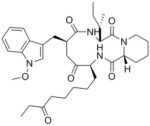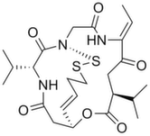Histone deacetylase (HDAC)
Histone acetylation is a key epigenetic process - it is upregulated during memory formation but downregulated in numerous neurodegenerative diseases (eg. Alzheimer's disease and Huntington's disease). There are 18 Histone Deacetylase (HDAC) enzymes that are classified into two groups, the histone deacetylase family and the sirtuin family. The histone deacetylase family is further divided into classes I, II and IV. HDAC inhibitors are a class of compounds that increase acetylation of lysine residues on histone proteins as well as other, nonhistone, proteins by inhibiting the activity of these HDAC enzymes. Researchers can save up to 50% on HDAC inhibitors from Hello Bio - they are up to half the price of other suppliers.
Dihydrochlamydocin (HB3874)
Description:Phytotoxin. Derivative of the HDAC inhibitor chlamydocin.
Purity:>95%
(R)-3-Hydroxybutyric acid (HB4640)
Description:Endogenous HDAC1, HDAC3 and HDAC4 inhibitor
Purity:>98%
(S)-3-Hydroxybutyric acid (HB4641)
Description:Endogenous HDAC1, HDAC3 and HDAC4 inhibitor
Purity:>98%










